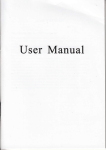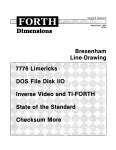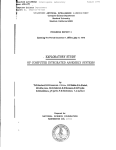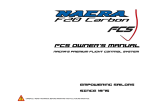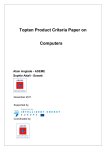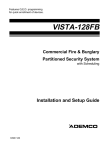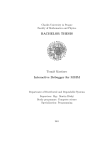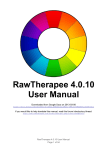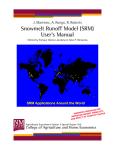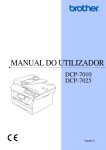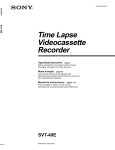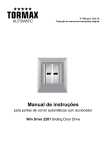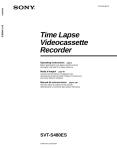Download EXSRM, an expert system for snowmelt runoff model
Transcript
New Directions for Surface Water ModelingÇProceedmœ of the Baltimore Symposium, May IAHSPubl.no. 181,1989. EXSRM, an expert system for snowmelt runoff model (SRM) E. T. Engman and A. Rango USDA H y d r o l o g y L a b o r a t o r y , B e l t s v i l l e , Maryland 20705 USA J . Martinec Federal Institute for Snow and Avalanche Research Davos, Switzerland ABSTRACT An expert system is being developed to assist unfamiliar users to set up and operate a complex model for simulating snowmelt runoff. The expert system encodes the procedures that experienced hydrologists use to set up input data, select parameters, and adjust these values when initial simulations do not match measured data. The expert system is built around an existing FORTRAN model which is not changed and does not need to be reprogrammed into a different computer language. INTRODUCTION Hydrological research during the past two decades or so can be characterized as the era of the computer and with it the development of a large number of complex simulation models. Many of these models are based on physical principles and some are spatially distributed in how they represent a complex basin. Still generalizing, most models have been developed and verified or tested on only one or a few data sets. Very few models have been subjected to rigorous testing. The net result of this research has been an increase in appreciation of understanding the complexity of hydrological processes in the natural environment but it has not resulted in new and better tools for practicing hydrologists and engineers. Few, if any, complex simulation models can be used without making a number of subjective decisions regarding model set-up and selection of model parameters. For the most part, the model developer or one intensively trained in the use of the model will achieve better results than a new user. Although these models are intellectually appealing because many are "physically based," they have not been used much in practice. Studies by Naef (1981) and Loague & Freeze (1985) demonstrated that the complex models do not necessarily give better results. Thus, there is little incentive to assemble the data and to become an expert in use of a given model. The snowmelt-runoff model (SRM) (Martinec et al., 1983) is such a model but with a few notable exceptions. First of all, it is comparatively more simple than many of the models that would fall under the discussion above. Secondly, it has undergone rigorous testing for various conditions, sizes of basins and geographic location. Nevertheless, it is a model that requires a number of decisions to be made by the user and it is a model with which an experienced user will achieve better results than the user with little experience. Expert systems incorporating the principal components of complex simulation models may be a viable method for making the models more usable for practicing hydrologists. Initially, at least, most 417 È. T. Engman et al. 418 models need some "calibration" or modification of inputs, parameters or coefficients to achieve suitable results. These steps also require experience with the model to evaluate just how reasonable the results are and which modifications are necessary to get good and hydrologlcally reasonable results. A well designed expert system should be able to assist a user in setting up the data and other necessary inputs. The expert system can at the very least guide the user in subjective tasks such as how to subdivide a watershed into model units and help him select initial model parameters and coefficients. A more advanced expert system should be able to act on its own to automatically make changes for the most common discrepancies. It is this area—evaluating model simulations and improving them by modifying inputs—that this paper addresses. An expert system is being built around an existing and well tested FORTRAN snowmelt runoff model. The expert system encodes the experience of the model developers to assist the new user in setting up the input data, selecting parameters and coefficients, and adjusting these values when simulated and measured runoff data do not match. The expert system guides an inexperienced user through the same sequence of steps that the model developers would use in a similar application. This paper discusses the design and strategy for developing an expert system for SRM to assist nonexperts in successfully using the model. THE SNOWMELT-RUNOFF MODEL SRM has been developed to simulate and forecast daily streamflow in mountain basins where snowmelt is a major component of the annual water balance. SRM is a degree-day model that uses the percentage of the basin covered by snow as the primary input. SRM was developed by Martinec (1975) for small European basins. With the advent of satellite snow-cover data in the 1970's, the model was shown to be usable in larger basins. Using Landsat data, SRM has been successfully run for various size basins in Europe and the United States (Rango & Martinec, 1979; Rango, 1980; Jones et al., 1981). Applications of SRM usually involve simulating snowmelt runoff for basins with some hydrological data, specifically measured discharge and one or more meteorological stations that measure precipitation and temperature. The minimum required inputs to the model consist of periodic snow cover area and daily temperature and precipitation. Each day during the snowmelt season, the water produced from snowmelt is computed, superimposed on the recession flow to yield the total basin discharge according to Equation (1). Q ,, = c [a (T + A T )S + P ] k'^/,Qrà x n+l n l n n n n nJ 86400 (1-k ,,)+Q k ,, n+1 x n n+1 where Q = average daily discharge in m-'s--'c = runoff coefficient expressing the losses as a ratio (runoff/precipitation). a = degree-day factor (cm - °C -1 'd~l) indicating the snowmelt depth resulting from 1 degree-day. (1) 419 EXSRM, an expert system for snowmelt runoff model T = number of degree-days ( ° O d ) . AT = the adjustment by temperature lapse rate necessary because of the altitude difference between the temperature station and the average hypsometric elevation of the basin or zone. S = ratio of the snow-covered area to the total area. P = precipitation contributing to runoff (cm). A preselected threshold temperature, T Q J J J , determines whether this contribution is rainfall and immediate. A = area of the basin or zone in m^. 0.01 _ . 2,-1 _ 3 _n c 86400 conversion from cm'm d to m - s ± k - recession coefficient indicating the decline of discharge in a period without snowmelt or rainfall: n = sequence of days during the discharge computation period. There are a number of steps a user must take before the model can be run. The user must determine the physical characteristics of the basin and select the model variables and parameters. After the basin boundary has been defined by the streamgage site, the basin must be subdivided into elevation zones separated by about 500 meters. The elevation zones are created in recognition that snowmelt is very elevation dependent and thus the model is applied to each of the zones to spatially distribute the rate of snowmelt. A hypsometric curve is developed for the basin and the mean elevation for each zone determined graphically. Input data to the model are air temperature, precipitation, and snow cover area. Ideally, temperature and precipitation would be measured within the basin and at each mean hypsometric elevation for each zone. Seldom is this the case in real basins. Usually these data must be extrapolated from one or more stations, some of which may not be in the basin. Snow cover area is used to determine where snowmelt can potentially occur and where certain algorithms unique to snow coverage should be applied. Usually the snow cover data are planimetered from remote sensing satellite data, and the individual measurements are used to construct snow-cover depletion curves for each elevation zone of the basin. Model parameters include a runoff coefficient, a degree day factor, a recession coefficient, and a time lag. Each of these can be chosen and modified by the user to adjust the simulation results. The model is set up with default values and the user's manual (Martinec et al., 1983) describes how the choices should be made. Typical applications usually require several iterations that involve changes in parameters or how the basin has been subdivided into equal elevation zones. Depending on how good the initial simulations were and what type of discrepancies exist between the measured and simulated hydrographs, the user chooses different strategies to improve the simulations. It is during these iterations that the experienced user works with a sequential plan based on accumulated knowledge whereas the inexperienced user will resort to a trial and error strategy. E. T. Engman et al. 420 EXPERT SYSTEM STRATEGY Figure 1 is a schematic illustrating the various parts of the expert system used to set up and run the simulation model. Building the expert system around the existing FORTRAN model allows one to get up and running in a relatively short time. An advantage to this strategy is that parts of the expert system can be implemented as they are developed. Each increment, such as an interactive graphics procedure for determining the recession constant, can be added as it is completed and tested immediately. An additional advantage to this approach is that verification and validation (Geissman & Schultz, 1988) of the expert system is simplified. Comparison with known simulation results validates the performance of the expert system. EXSRM is the expert system incorporating SRM to assist an unfamiliar user to set up and run the simulation model. At the front end of EXSRM a series of help windows and mousable menus assist the user in setting up the model and loading the hydrologie and climatological data. Default values are displayed and choices (such as output options) can be made simply by mousing to that item and "clicking" it over to the alternative choice. These options are illustrated in Fig. 2. Under the SRM Parameters window the current choice is indicated by bold print. This can be changed by moving the mouse to the light print and clicking the mouse button. The different model variables can be edited by first choosing the specific variable from the menus in the Message window. For example, to change the rainfall runoff coefficient, one would use the data point editor which displays the existing CR values for Fig. 1. Schematic of the expert system and its interaction with mainframe computer and the FORTRAN simulation model. 421 EXSRM, an expert system for snowmelt runoff model SRM Parameters Top -Labeling Optic liane of Basin VearHunber of 2on Model Run Hun Model Run Opti. Mode Starting Month Ending Month 1180.8 Elevation of Base Station Input Data Units Metric English Rctual Runoff Data Exists Does not exist Precipitation Data By Zone Not By Zone By Zone Not By Zone Runoff Coefficients Print Input Data Yes No Print Runoff Data Plot Computed Us. Actual Runoff Echo to PrinterTenperature Optic >SRM-Rel-?>Bas' ns>DUMMV BPSIfi 1982.Bas >SRM-Rel-7>Bas ns>FELSBERG BASIN 1982.Bas >SRM-Rel-?>Bas' , >nadis< verl9?8.basir >SRtt-Rel-?>Bas ;>nadisi verl9?6.basin.: >SRM-Rel-?>Bas ,>nadisi ver 1978.bas • >kabul 1976.bas>SRM-Rel~?>Bas >SRM~ReW>Bas >9arbagel9?6.ba: >SRM~Rel-7>Bas >felsberg82.bas >SRM-Rel-?> >boise riverl978.bas .1 >SRM-Rel-?> >boise river 1978.b, More be tow Exit D are now pointing at the Help uindou. Here, Help information about Ex-SRM is c updated. Effective Mouse Clicks: Right Button - Pop up a Menu of Options. E*-SRH Qptii Execute SRM with current data View Current Plots (Edit Ivjariabîësl Calculate Recession Constant Edit Curves Print Runoff Plots Save Current Data to Disk Run Ex-SRM Map Handler Exit EX-SRM ^^*M^3*^Ss*«-îîï*î«^aî&*ffi»fe!aasfe*iasSJ F i g . 2. Monitor showing user options on menu-choice i s to "Edit Variables." Uindou Systeri Edit by ng V a r i a b l e Ronan CR Of Zone C For Basin Ex-SRM TUr.a P o i n t E d i t o r FELS8ERG BFlSIM firea: 8.60 0 m em a 60 e fin e fin 21 22 23 a 50 98 0 98 0 98 0 98 31 0 6G 19 0 0 0 8 0 0 8 8 8 0 G Q 8 8 8 8 0 0 0 0 0 0 0 0 fV'Vii-H^lfliViiLv [Thu 22 Sep 12:49:59] Fig. 3. values. fin fin fin fin fin fin fin fin fin fin fin fin 68 68 t>8 R e f r e s h ! 68 Select 1 68 60 60 60 60 60 60 60 ES | Rugust Jul, June «.y April 0.60 0 60 0 60 B 60 6 60 8 60 8 60 8 68 8 68 8 68 8 68 0 60 8 8 0 0 0 0 0 B 0 B 0 0 0 0 0 6 0 60 8 60 8 60 68 60 60 60 60 60 60 60 60 66 8 68 8 68 0 60 60 60 60 8 60 iîkiÀÛÊÊïÊÊWIÊÊBËÈÈÊÊÈ sterbenz Tabular runoff c o e f f i c i e n t s 0.68 0.60 0 68 0 60 0 60 0 60 8 60 8 68 8 68 0 68 0 68 0 68 0 68 8 68 8 68 8 68 8 68 8 60 0 60 0 68 0 68 for e d i t i n g by typing in new E. T. Engman et al. All each elevation zone. Any value can be changed by selection with the mouse and options (Fig. 3) and typing in the new value. Results of the simulation are presented graphically on the color monitor and tabularly on the B&W monitor. Comparisons of the simulated and.measured volumes for the total simulation period are presented as well as statistical measures of fit. If the results of the initial simulation are not nearly perfect the user will attempt to improve the results. In studies of a large number of simulations for basins of varying sizes and climates, Martinec & Rango (1986) have concluded that when major simulation discrepancies have occurred in the past it has been mostly due to errors in input data rather than improper selection of model parameters. Thus, when attempting to improve model simulations, one should not randomly start modifying model parameters. Experience has shown that careful re-evaluation of the input variables should be the first step. There are two basic strategies used to help the user improve his simulation results. The first is based on the volume difference and the goodness of fit statistic. The second is based on the graphical results and relies on the user to make subjective evaluations. Each of these two strategies are explored further below. Percentage of volume difference and goodness of fit statistic The SRM computes two statistics to describe the simulation accuracy: a measure of model efficiency and a volume comparison. The measure of model efficiency is the Nash-Sutcliffe (1970) goodness of fit statistic R~, defined as n 2 R ' 2 (Q. - QJ 2 = l_i=i n I i=l (2) -2 (Q. - Q) 1 where Q = measured daily discharge, Q' - simulated daily discharge, Q = average daily discharge for the simulation year or simulation season, and n = number of daily discharge values. The volume comparison is defined by D V - V R = -1 V R . 100 (3) where D y = the percentage difference between the total measured and simulated runoff (%); V R = measured runoff volume; and V = simulated runoff volume. The EXSRM will automatically suggest certain steps to be taken by the user if the runoff volume difference exceeds ±5% or if the R^ value is less than 0.75 (these thresholds can be changed). EXSRM leads the user through a sequence of steps that the expert has learned by repeated experience with the model to be the most efficient for improving the model simulations. In order of effectiveness, these are: EXSRM, an expert system for snowmelt runoff model Re-evaluate the snow cover depletion curves. The snow-cover variable, S, of an elevation zone or basin is usually obtained from a variety of sources of snow-cover data including ground observations, aircraft photography, and satellite imagery. These data should be rechecked for possible interpretation errors. EXSRM graphically displays the depletion curve for each elevation zone. The user can redraw the curve by tracing a new curve with the mouse and these points are automatically inserted in place of the previous curves points. EXSRM can then be rerun to get a new simulation. Instructions for evaluating the curves and for making changes are given in an accompanying window. Reconsider the lapse rate. The calculated degree-day values must be extrapolated from a base station to each elevation zone using a suitable lapse rate. The temperature lapse rate must be carefully determined, especially if the observation station is situated at a low altitude and the extrapolation of degree-days is made in only one direction (upwards). Instructions are provided in a window for evaluating the lapse rate and if simulations have previously been made for the subject basin, the user can examine these values. Adjust the runoff coefficient. The model requires a runoff coefficient, c, that is a ratio of runoff to precipitation. Because the runoff coefficient is likely to vary throughout the year as a result of changing vegetation and soil moisture conditions, the SRM computer program permits changes in c every 15 days. Usually, c is higher for snowmelt than for rainfall. Therefore, the model can handle different runoff coefficients for snow, eg, and for rain, cg_, as determined by the user (Fig. 3 ) . Reconsider the degree-day factor. The degree-day factor is used to convert degree-days to snowmelt expressed in depth of water. In the absence of detailed temperature and snow pillow or lysimeter data, the degree-day factor can be obtained from an empirical equation developed by Martinec (1980). The effect is similar to 2, above. Evaluate the precipitation input data. Measurement of representative precipitation amounts in a mountain basin is extremely difficult. Extrapolation of precipitation amounts from one or more base stations to zones in the basin must be based on user knowledge of the study area. Errors in precipitation data may result in volume errors as well as errors in the peak discharge. If precipitation is determined to fall in the basin on a given day, a critical temperature, TcRIT» m u s t lDe examined to determine whether the precipitation is rain or snow. •^CRIT i-s usually selected to be slightly above the freezing point and may vary from basin to basin. The distinction between rain and snow is important in SRM because the rain contribution to runoff is on the same day that the rain occurs, whereas the snow contribution to runoff is delayed. Evaluation suggestions are given in instruction windows and modifications can be implemented with the data point editor. E. T. Engman et al. 424 Subjective evaluation of graphical output Modify the recession coefficient. The recession coefficient, k, is exponentially related to the current stream discharge. The k value must be determined by graphical procedures computed from daily discharge data for the given basin. For this determination, daily discharge values for the snowmelt season or the whole year are used. If no discharge data are available for a basin, recession coefficients can be estimated from empirical formulas based on basin size (Martinec et al., 1983). The user will be asked to evaluate the graphical comparison of the measured and simulated hydrograph. If the computed hydrograph arises or drops too rapidly the recession coefficient should be increased, and vice versa. The user will be guided to use an interactive graphical procedure to redraw an envelope line that computes a new recession coefficient (see Fig. 4 ) . Modify the time lag. Snowmelt runoff is computed for a time lag between the rise in temperature and the rise of the hydrograph of 18 hours. If the time lag is not conveniently 18 hours, the computed discharge values must be shifted by a certain number of hours to facilitate comparison with published streamflow data. In large basins with multiple elevation zones, the time lag changes during the snowmelt season as a result of the changing spatial distribution of snow cover with respect to the basin outlet. Discrepancies in the timing of flow peaks and troughs may be due to incorrect time lags. EXSKM asks the user to evaluate the timing and guides him through changes, if necessary. Recession Constants This is a Log-Log plot. Using Metric units. f^NÉU'ÊSt/im^ .. 5 EïatlseHosER);:; H •' EîRLtt S ^ R O E -•<* / - • : < •£> Qn*l REDRAW REPLACE y s s xteûEH - INSTRUCTIONS FOR DRRUING RECESSION LIME Moue the nouse pointer to a point that locates the louer end of the recession line. encra Press the Left nouse button to set the lower left point for the recession line. Moue the nouse pointer to a point that locates the upper end of the line. Press the Center nouse button to set the upper right point and drau the line. fn-re' Press the Right nouse button. REQRRH lets you do it all over again. REPIRCE updates the data constants. RBORT returns to nain window (no update). S er-3 7. 2 3 4 5 6 ' real H HELP HINDOU DISCHARGE Q n 1.1613917. . -S.13812153.I [Thu 22 Sep 12:4U:16] sterben; Fig. 4. Example of interactive graphics use to compute new recession constants. EXSRM, an expert system for snowmelt runoff model 425 Figure 5 is an example of the simulated and measured hydrographs plotted on the screen. The user is able to visually evaluate the match of peaks to judge if the lag needs to be changed. Window S y s t e n b y Reman x\\'.-.-'-.'vV.SBM-.--P«rr«Wè'te>r»\--^V->\-..^.-..'-\-./.V-.'- •: « » s Snowmelt R u n o f f fïà'rtfi •tëvc Horib Wo'ds FELSBERG BASIN Solid È'rvd-ï :£;i:«V 1982 Run number •$f;6£fti;9^^^ ==> Measured data Dotted ==> Computed data ïrip'ij ftijnn .Echo C 1000 b 900 c 8°° m 7Û0 t 600 e 500 s 400 P e r 300 s e c 0 This graph w i l l be sent to the Laser P r i n t e r . Ej 1 I f you do not wish t o p r i n t t h i s H graph, then c l i c k on ABORT. | I f you c l i c k on SEMD, ther the graph u i l l be p r i n t e d . Hjk 200 100 The p r i n t e r takes a long t i n e t o process the data. Expect a delay (roughly 3 n i n u t e s ) . • =a^ Hindou 24 0 0 30 d 60 90 T I M E (days) 120 150 ;;^ttôl^-fh;9;;!;i'M'\t;b^ Hindou 25 lill M ^ ^ ^ k » ® ?«««* [Thu 22 Sep 11:34:151 sterbenz Fig. 5. Example of measured and model simulated hydrographs for user comparison. The trial simulations that the user makes can all be saved and recalled for examination. Likewise, the different graphical displays can be buried and later redisplayed. Rapid recall and comparison capabilities allow the new user to become familiar with the model operation and to understand the relative sensitivity of the various parameters and input data. It encourages him to experiment with different combinations of inputs. However, buried within EXSRM are limits for the various parameters and variables. If the user chooses an unrealistic value, the program will warn the user that this value is outside the physically reasonable range. For example, if a user chooses a critical temperature of -10°C the program will warn the user and indicate what the range of physically acceptable values is. This prevents random and meaningless fitting. SUMMARY An expert system has been developed to assist unfamiliar users in simulating snowmelt runoff with a complex FORTRAN model. This use of an expert system appears to be a very useful approach to making complex data intensive simulation models easily usable. Building an expert system around an existing simulation model allows one to get up-and-running in a relatively short time. An advantage to this approach is that parts of the expert system can be implemented as 11 E. T. Engman et al. 426 they are completed without affecting the model operation. Since the FORTRAN code itself is not changed, historic inputs and parameter estimation can be mixed with the expert system developed inputs and parameters. Thus, as the expert system grows, it encompasses more of the heuristics that an experienced operator would use to get good results. Extending this thought a step further, the expert system will be able to "learn" from experience. The role of snowmelt forecasting is to forecast runoff for a specific basin year after year. Extreme events usually cause the forecaster problems because his experience had not previously encountered such events. The expert system would behave similarly; thus, it would not be able to do better than the experienced forecaster for the unusual events. However, the expert system should be able to "remember" these events by storing them in the knowledge base. Once in the knowledge base, it should be able to profit from this when a new event, some time in the future, has data characteristics that indicate it may be unusual. REFERENCES Geissman, J. R. & Schultz, R. D. (1988) Verification and validation of expert systems. AI Expert 3(2):26-33. Jones, E. B., Shafer, B. A., Rango, A. & Frick, D. M. (1981) Application of a snowmelt model to two drainage basins in Colorado. Proc. 49th Annual Western Snow Conference, St. George, Utah, 43-54. Loague, K. M. & Freeze, R. A. (1985) A comparison of rainfall-runoff modeling techniques on small upland watersheds. Water Resour. Res. 21(2):229-248. Martinec, J. (1975) Snowmelt-runoff model for streamflow forecasts. Nordic Hydrol. _6(3):145-154. Martinec, J. (1980) Hydrologie basin models. In: Remote Sensing Applications in Agriculture and Hydrology, Fraysee, G., editor, A. A. Balkema, Rotterdam, 447-459. Martinec, J., Rango, A. & Major, E. (1983) The Snowmelt-Runoff Model (SRM) User's Manual. NASA Reference Publ. 1100, Washington, D.C., 118 pp. Martinec, J. & Rango, A. (1986) Parameter values for snowmelt runoff modeling. J. Hydrol. 84, 197-219. Naef, F. (1981) Can we model the rainfall-runoff process today?. Hydrol. Sci. Bull. .26(3), 281-289. Rango, A. (1980) Remote sensing of snow covered area for runoff modelling. Hydrological Forecasting (Proc. Oxford Symposium), IAHS Publ. no. 129, Oxford, U.K., 291-297. Rango, A. & Martinec, J. (1979) Application of a snowmelt-runoff model using Landsat data. Nordic Hydrol. _10(4), 225-238.










